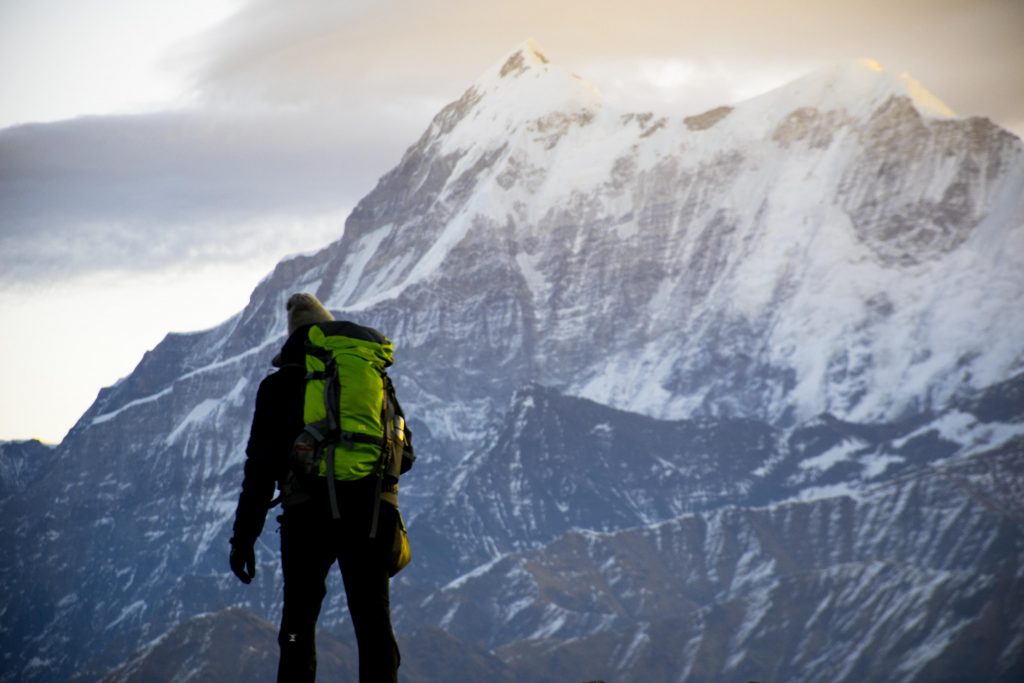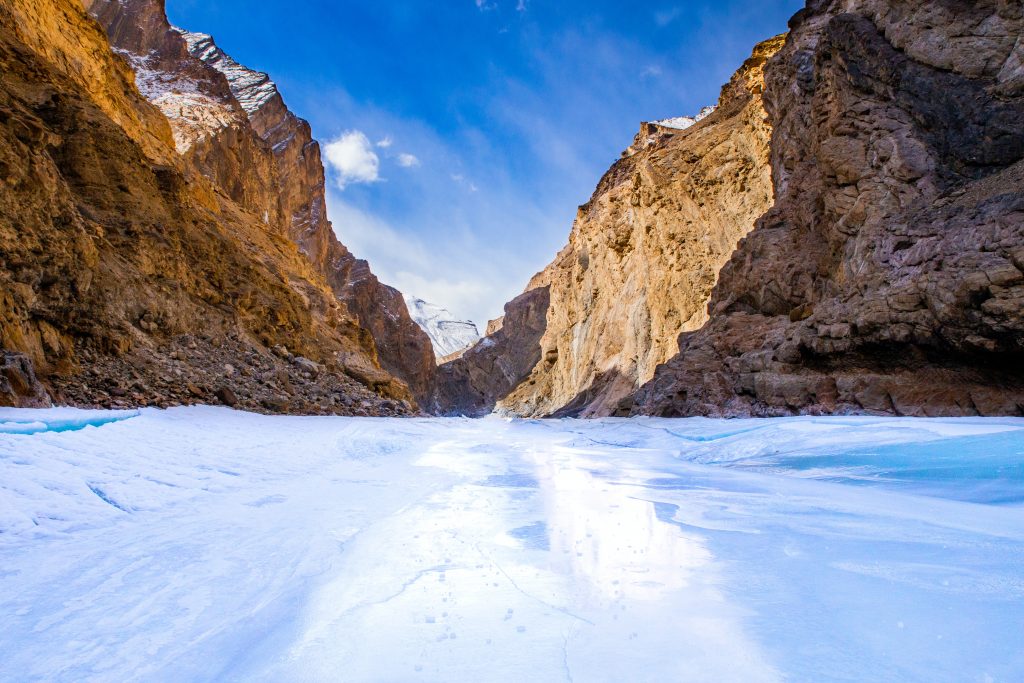There is something riveting about winters in India, especially in its snowy regions. You witness trees laden with snow, mountains shrouded in mist, and the cool winter breeze just stinging the surface of your cheeks. And there is no better way to experience all of that than trekking your way along some of India’s finest winter routes in all their glory. So, you want to go on winter treks in India, but just don’t know which are the best? Continue reading our guide to know more.
Brahmatal Trek, Uttrakhand
Brahmatal is a lake embedded deep within the interiors of the Uttarakhand Himalayas. If you’re a newbie just understanding the realm of trekking, you might want to get a hang of it first by starting off easy. Taking on challenging winter treks in India without having some experience can be extremely strenuous. So, to test whether you’re made for trekking just yet, try the Brahmatal trek first. The trek is easy since the slopes are gradually ascending, consequently eliminating any extreme climbing. Plus, most of the trek is under forest cover, reducing the probability of altitude sickness.

Once you reach the 12,251 ft summit, you will feel the peaks are just within your grasp because of how close they feel. It’s a sight to behold! End the trek by camping along the glacial lake and singing a few campfire songs. Start with Country Roads by John Denver. That’s a classic!
Duration: 6 days
Difficulty: Easy
Kedarkantha Trek, Uttarakhand
Kedarkantha trek (not to be confused with Kedarnath) is one of those winter treks in India to explore your trekking abilities. The trek route runs through the Govind Pashu Vihar National Park in Uttarakhand. Known as the “Queen of Winter Treks” it’s famous among beginners because of its uncomplicated terrain. But it doesn’t mean that it’s unchallenging in any way, so you’d better quit being a couch potato! You do need an adequate amount of fitness level to climb and scurry up and down the trek route.
Kedarkantha is not about aesthetics but also about myths and magic! There are many legends and myths associated with the formation of this place. For instance, the name itself literally means the “Throat of Lord Shiva.” Think about that while you’re preparing for the trek to give you that desire to see it in person. And of course, you have the magic of the summit; after all, so much of its fame is due to it being a summit trek!
When you begin to gradually climb, you will notice some of the most splendid peaks around such as Swargarohini, Bandarpunch, Kalanag, and Draupadi ka Danda. But most of all, the sky peppered with starry clusters is what you should look forward to. Once you reach the summit, you will be able to have a bird’s eye view of the Himalayan ranges in all their grandeur. This will indeed give you a sense of accomplishment and satisfaction.
Duration: 5-6 days
Difficulty: Easy
Har Ki Dun Trek, Uttarakhand
With its lofty snow-covered terrain, rich culture, and vibrant history, the Har Ki Dun trek will certainly take you back in time and make you feel like Julie Andrews from The Sound of Music. While trekking across its 11,500 ft terrain, it’s impossible to miss the villages hemmed into the outskirts of the mountain. Since the people are welcoming, drop into one of the homes and learn a bit or two about the Har Ki Dun culture.
You might need to have some experience in rock climbing since its terrain is uneven and rockier than the others. This adds to the difficulty element. Inexperienced climbers might struggle a bit, so having some experience is necessary.

Duration: 7-9 days
Difficulty: Moderate
Goechala And Dzongri Trek, Sikkim
If you want to have a better look at Sikkim’s most celebrated peak, Kanchenjunga, then try the Goechala and Dzongri trek. Goechala is one of India’s less popular treks, but my oh my are the views as stunning as ever. The terrain is challenging, but in the end, the splendid peripheral view of the 14 other summits Sikkim has is astonishing. Trekking to this summit is like a journey – you get to visit a snow-covered alpine forest, the deep Goecha lake, and the Samiti Lake, each one as inviting as the last!
Also, don’t miss the splendid sunrises and sunsets while camping on the summit. They will certainly leave a mark on your memory, as will the view of Kanchenjunga. But make a note – only experienced trekkers should be attempting this trek!
Duration: 10-11 days
Difficulty: Difficult
Chadar Trek, Ladakh
If you think the film Lakshya has properly encapsulated the beauty of Ladakh, wait till you actually visit the place. And you can breathe in some of that beauty by attempting the Chadar trek. The Chadar trek is one of the most popular and unique winter treks in India. Now you might ask, what makes this trek unique? The fact that you have to walk on a thick ice layer of a river surrounded by icy mountains is a unique feature by itself. It’s like walking on a skating rink, without the ice skates, of course!
If you would like to see water frozen in time, check out the Nerak waterfall along your route. It’s beautiful, charming, and maybe closest to what you call “bullet time.” Dodging the thin spots of ice, making your way across a frozen river, you get to see an untamed side to Ladakh’s winter. And at the end, you can jump right into the river for an icy dip like no other! Needless to say, the Chadar trek requires some level of experience with treks in the past. You should also ideally be fit enough to take on the challenge.

The Chadar Trek may not last long with the impending climate change and rarely-frozen Zanskar river, but it will always remain one of India’s best winter treks.
Duration: 9 days
Difficulty: Moderate to Difficult
Some Pointers When Attempting The Best Winter Treks In India
Winter treks are a great way to bond with new explorers while scouting rugged terrains. The journey from the foothill to the summit or to the end of the trek is an enthralling and rewarding experience altogether. Amid all that excitement, you may forget a thing or two about certain trekking precautions. That’s why we have curated a couple of points reminding you to prepare efficiently and to follow certain measures while trekking.
- It will be natural to carry heavy woolen clothes for better protection from the cold. While trekking, you have to do the complete opposite. You have to “Keep it light.” Doing this will ensure better flexibility to climb any treacherous terrain. Heavy woolen clothes will just slow you down but you can carry one or two for the night. If you feel a bit chilly, carry a few extra thin thermals and wear them on top of each other.
- People have different resilience levels to cold temperatures. Some may choose to keep their face slightly open, whereas some may choose to cover their face entirely. No matter where you stand, it’s always better to cover some part of your face since temperatures can fall at the drop of a hat. Also, you don’t want to return to base looking like a White Walker.
- Trekking is all about connecting with nature. With all that grabbing and climbing, you’re surely going to have sweaty, dirty palms. To wash them, use hand sanitizers instead of water. Heating water at such altitudes takes an eternity, which means more usage of resources.
- Ultimately, follow all instructions by your team leader(s) since they’re way more experienced than you and know all the ins and outs of the terrain. Also, respect your fellow trekkers because they will be the ones who will help when things go south. If you have any medical conditions, speak to your team leader beforehand and listen to what he says. There are many winters but there is only one YOU.
So What Are You Waiting For?
Switch off your phones, close your laptops, and head to any of the treks we have mentioned. After all, these are just a handful of the best winter treks in India, and there’s a bunch of them waiting for you! Trust us, it will be a surreal experience that will open your mind. Lucky for you, goSTOPS is present in several locations across India, including in many base cities as well. The only way to properly end your trek is to come back to our homely, warm and comforting dorm room with your new trek pals. Happy Trekking!
FAQs
Is Trekking Good In Winter?
Although challenging, trekking in winter is one of the best feelings in the world (no, we are not exaggerating). For an immense snow experience, visit these winter treks from mid-December to the end of March. But you also need to be physically fit to handle the challenge of the cold weather plus the physical strain.
How Do You Trek In Snow?
Wear gumboots to counter slippery hard ice (like on the Chadar Trek). For loose snow, carry a trekking pole for an easy climb and use gaiters – coverings that protect your feet from snow, water, or any debris from entering. Most importantly, follow your leader’s guidelines.
Which Are Some Of The Most Difficult Treks In India?
Apart from Chadar Trek and Goechala & Dzongri Trek, some other treks which will take your trekking experience to the next level are:
- Stok Kangri Trek, Ladakh
- Panpatia Col Trek, Uttarakhand
- Pin Parvati Pass Trek, Himachal Pradesh & Spiti
- Kang La Trek, Himachal Pradesh (Lahaul) & Zanskar


